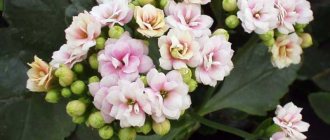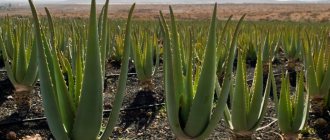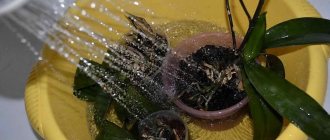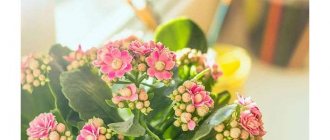What humidity does Kalanchoe need?
Since the last century, Kalanchoe has been gaining popularity among lovers of indoor flowers. This unpretentious culture will not only purify the air in the house, but will also decorate it. For abundant and bright flowering, watering plays a very important role.
As you know, the homeland of Kalanchoe is hot countries. hence its high adaptability to hot, dry weather.
During regular watering, the fleshy leaves accumulate moisture and use it when, for some reason, it is absent.
For normal growth and development of Kalanchoe at home, it is necessary to maintain the humidity level within 50% -60%. Excess moisture or lack of it does not affect the appearance of the succulent in any way. In hot, dry conditions, the short fibers on the leaf blades are able to absorb the required amount of moisture from the air.
IMPORTANT! However, you need to water Kalanchoe according to the regime. This is important for normal long-term flowering.
Normal home conditions are favorable for the flower. Kalanchoe does not need additional spraying; it is enough to take a summer shower for hygienic purposes or simply wipe the leaves with a damp cloth. In winter, during the dormant period, spraying is completely contraindicated; it can cause diseases.
Features and Issues
It’s rare that anyone can remain indifferent when passing by a flower shop with Kalanchoe bushes on display. The lush caps of inflorescences amaze with their magnificence and variety of colors - milky white, foamy pink, crimson, orange, bright red... Of course, it is impossible to resist buying this living joy! But, I think, many are already familiar with the situation when, after a lush and prolonged flowering, a bush begins to lose its decorativeness and attractiveness.
First, the inflorescences wither, then thin branches stretch out, the leaves become smaller, the stem becomes bare and becomes woody. In this form, the plant can hardly be called a window sill decoration. What to do? In such a situation, some simply throw away the faded specimen and forget about it.
Lush caps of inflorescences amaze with their splendor and variety of colors
Others intensify their care and rush to save the bush with all their might: they intensively fertilize it, replant it in a new pot, place it closer to the sun or vice versa, put it in the shade. But, as a rule, all these activities do not bring visible results.
I hasten to reassure you, this “behavior” of Kalanchoe is not at all bad care or inappropriate conditions of detention. It’s just that for an aesthetic appearance, the bush needs constant rejuvenation - be it heavy pruning or rooting cuttings. But for lush, long-lasting, and even repeated flowering, you need a certain light regime, compliance with certain watering features and a fertilizer application schedule.
Therefore, if you decide to master the successful technology of growing indoor Kalanchoe, it is worth getting to know it better.
How often do you water Kalanchoe?
There is one important rule for Kalanchoe - it is better not to top it up. In this case, the flower will take the missing moisture from the leaves, but excess moisture will definitely harm it.
How often to water at home depends on the growing season. In spring, when the flower is intensively growing green mass and flower buds are actively developing, it is watered 1-2 times a week.
In summer, with the onset of dry, hot days, the frequency of watering can increase to once every 2-3 days. In this case, you need to be absolutely sure that the soil has dried out to a depth of 1-2 cm and definitely needs watering.
In autumn and winter, when all the inflorescences have faded and the flower, being at home, goes into a dormant period, the frequency of watering is reduced to 3 times in 2 months.
IMPORTANT! It is necessary to water carefully so that drops do not fall on the leaf plates, and the soil is completely watered and there are no unwatered clearings left.
Watering in summer
How many times should I water Kalanchoe in summer? The dense, fleshy foliage of this plant can accumulate moisture inside, so the crop is perfectly capable of going without watering for several days without experiencing any discomfort. But with the arrival of summer, it is still necessary to pay a little more attention to the bush.
When answering the question of how much to water Kalanchoe in the summer, you should pay attention to the fact that the signal for this process will be the top dried layer of soil. If the soil is wet, then this activity should be postponed for a few more days.
Based on this, we can conclude that the soil is moistened approximately once a week, provided that the plant is kept at moderate summer temperatures. If the summer turns out to be hot, then watering is carried out every 3-4 days.
How do you know when it’s time to water your Kalanchoe?
The first sign that a flower needs watering is its drooping appearance and the leaves beginning to fall off. In this case, you should not immediately water the soil in the pot abundantly, but you should gradually water the soil and spray it with a spray bottle.
In general, when growing Kalanchoe at home, you need to perform the most common actions of a gardener in caring for any flower crops. For example, you constantly need to observe the frequency of irrigation and monitor the condition of the soil.
Basic rules of watering
There are several simple rules for watering plants at home. If you follow all the recommendations on how to water Kalanchoe at home, you can guarantee the health of the crop. This is the only way you can grow a strong and beautiful bush.
What are the main rules of watering? How to water Kalanchoe at home?
- For irrigation, use only boiled or pre-settled water. In addition, the liquid must be free of sediment. Thanks to this, calcium and magnesium salts do not enter the soil. Therefore, before watering Kalanchoe, be sure to prepare the water.
- The temperature of the liquid should be room temperature. The fact is that cold water can cause rotting of the root system, as well as the development of other unpleasant diseases. This is one of the basic rules regarding how to water Kalanchoe.
- During the watering process, it is necessary to ensure that the liquid does not get on the trunk, as well as on other parts of the crop. The fact is that for this reason, unsightly brown spots and rot can form on the plant.
- Speaking about how to properly water Kalanchoe at home, you should also pay attention to the fact that it is necessary to monitor the soil moisture, while preventing it from drying out and becoming waterlogged. Therefore, a small amount of water is taken for irrigation.
- 30 minutes after watering the soil, all excess liquid that remains in the pan must be removed.
- It is imperative to place a layer of expanded clay at the bottom of the pot with the plant, which will serve as drainage. Thanks to this, all excess moisture will disappear.
How often to water Kalanchoe at home?
The frequency of watering will depend on the condition of the soil. A sign of lack of moisture is drying, falling leaves. In this case, watering should be regular, but very moderate. Yellowing and a long absence of flowering, as well as rotting of the foliage, indicate an excess of moisture in the soil. This situation can be corrected by completely replanting the plant, replacing the earthen ball.
Thus, when considering how often to water a Kalanchoe plant, it will largely depend on the condition of the soil. Monitor its moisture regularly.
What kind of water does an indoor flower like?
For irrigation, it is recommended to let the water sit for a couple of days. During this period of time, chlorine, which is harmful to ornamental plant crops, will be released from the liquid. The liquid for irrigation should not be colder than room temperature.
Disputes often arise among flower growers regarding the use of boiled water. On the one hand, this is a good option, since harmful impurities evaporate when boiled. At the same time, useful micro- and macroelements necessary for the normal development of the flower are destroyed along with them. To replenish them you will have to use mineral supplements.
Another disadvantage of using boiled liquid is that it contains a minimal amount of oxygen, and to maintain the balance you will have to frequently loosen the soil.
Forming and pruning Kalanchoe
Over time, the indoor flower begins to stretch upward. At first, the green friend looks compact and miniature, like a squat bush, but gradually its decorative properties deteriorate. The foliage becomes smaller and the stems become longer. To restore the beauty of the Kalanchoe flower, pinning and pruning are necessary.
The last procedure is carried out after the flowering stage. Cut off long stems and remove faded flowers. Young shoots will emerge from the cuts. To branch them, they are pinched. Flower shaping and trimming is usually done in summer or spring. By the beginning of autumn, the plant will produce many young shoots with flower stalks.
How to properly water Kalanchoe at home
Irrigation of flowers growing at home is carried out in several ways, which are also appropriate when watering Kalanchoe. Each method has its own nuances, which are recommended to be performed so as not to harm the exotic perennial.
Spraying the roots
This method of watering at home is most often used when replanting Kalanchoe. In order to make sure that the root system is healthy, the earthen ball is sprayed with a spray bottle and the roots are carefully freed from the ground.
At home, this method of watering is also used to treat the root system with agents that stimulate the growth of succulents.
Running water
This irrigation method is more often used when the flower is affected by insect pests or for preventive purposes. At home, a similar watering method is effective when replanting a flower to make sure that the condition of the rhizome is normal. This method of watering is also used at home when carrying out hygiene procedures in the summer.
Watering from above
The most commonly used method of watering Kalanchoe. It is completely safe for Kalanchoe, since when using it you can clearly control how much water you pour, and accidental contact with leaves and inflorescences is completely excluded.
Watering using this method should be done using a small watering can with a thin long spout for convenient holding of the event.
The top-watering method can be used at home during all growing seasons.
Dive
Immersion in water is a very convenient method, but it requires some time and special attention. The pot with the flower is placed in a large container filled with water and left until air bubbles stop appearing on the surface of the water.
ATTENTION! Experienced gardeners warn that frequent use of this watering method at home will inevitably lead to the onset of rotting processes.
Growing conditions and care
It must be said right away that modern varieties differ significantly from the plants we are familiar with from childhood. Remember, the Kalanchoe that grew on my grandmother’s windowsill was much taller and more spreading than its store-bought counterparts. He was distinguished by his unpretentiousness and tolerance, without any particular offense towards the owner’s forgetfulness in watering and replanting, and caused a minimum of trouble.
But its flowering was quite modest: small, scattered and quickly falling flowers, unfriendly buds blooming. Against their background, the luxurious inflorescences of modern Dutch hybrids are simply enchanting!
But not many people know that such varieties were bred for street decoration. They were used to decorate flower beds, flowerpots with flowering bushes were displayed on open terraces and balconies, and they were used to decorate the entrance to the house and recreation areas. So, based on the selective characteristics of these hybrids, it is most logical to throw away the Kalanchoe after it has flowered, but not everyone will raise their hand to do this. In this case, we will independently restore, propagate and grow compact flowering bushes.
Basic conditions of detention:
- The soil. It should be quite loose and nutritious. The best option would be the top layer of soil from the forest, but ordinary garden soil with the addition of humus or compost will do and further care will not be necessary without regular fertilization.
- Lighting. Kalanchoe is a tropical plant, which means that direct sunlight does not burn it, the light must be intense, but diffused. A similar regime in an apartment can be created by placing the pot on the south-east, south-west window sill or near the south window in light shade from the curtain. To stimulate flowering, the plant needs to artificially organize a short daylight hours, lasting no more than 8-10 hours.
- Fertilizers. Considering that a compact bush grows for about a year and a half before it requires rejuvenation, the nutrition contained in the soil is sufficient for it. Additional organic fertilizers (humate, herbal infusions, peat) are usually applied only during the flowering period. At the same time, it is necessary to strictly limit the supply of nitrogen components, after which a lush growth of greenery may occur instead of flowering, so no selitol, ammonia and urea. When buying ready-made nutrient concentrates, choose those designed for fertilizing cacti or succulents.
- Rest. Plants need a period of rest to prepare and gather strength for future flowering. At this time, care consists of limiting watering, changing the light intensity and lowering the air temperature. Typically, it is recommended to take rest at the end of winter - beginning of spring.
- Rejuvenation. You can maintain the decorative appearance of the bush by regular pinching and pruning, while the cut cuttings are rooted in water or wet sand, and then planted in a separate pot, obtaining a new, young plant. And in order for the remaining stump of the old bush to produce new shoots faster, it needs to be transplanted into new soil and covered with a transparent bag or glass jar.
- Watering. Kalanchoe, like most succulents, does not tolerate high soil moisture, leading to rotting of the roots and even death of the plant, but at the same time, drying out of the earthen coma can negatively affect flowering. Therefore, drainage holes must be made in the bottom of the new pot. Special care and caution in watering are needed in winter, and in summer, water only after the top layer of soil has dried.
Important! To prevent the development of fungal infections and putrefactive processes in the soil, it is enough to place several charcoals on the bottom of the pot during replanting, and add wood ash to the soil mixture.
What can you water with and what fertilizing and fertilizers can be applied along with watering Kalanchoe?
Watering Kalanchoe does not just mean using clean water. Along with water, it is recommended to add iodine, hydrogen peroxide and other substances often used by people to feed perennials.
Hydrogen peroxide
A mixture of water and peroxide has a positive effect on the roots, helps get rid of diseases and accelerates flower growth.
To prepare the composition you will need 1 liter of clean, settled water and 2 tablespoons of hydrogen peroxide. You can water immediately, but not more than once a week.
If you reduce the concentration and take only 10-15 drops of peroxide per liter of water, then you can spray the prepared composition on Kalanchoe. This procedure will relieve and protect the flower from insect pests.
Iodine
Water containing iodine will rid perennials of pests and help weak plants gain strength and energy.
To prepare the solution you will need 3 liters of water and 1 drop of iodine. It is recommended to water with this composition at home no more than once a month.
Shell
The shell perfectly regulates the acid composition of the soil and is considered a source of calcium, which is necessary for all living organisms.
Before use, eggshells are thoroughly washed, dried and crushed in a mortar.
The shells can be added to the soil in the form of crushed powder or in the form of an infusion. To prepare, infuse a handful of shell powder in 3 liters of boiling water for 5-6 days.
succinic acid
Succinic acid is considered one of the cheapest biostimulants for Kalanchoe. It is often used for quick adaptation after transplanting a medicinal plant.
1 tablet of acid is dissolved in one liter of water and used only once a season.
Sugar
Sugar supplements have always had a beneficial effect on the appearance of the flower and abundant flowering. Fertilizing with sugar involves adding dry matter or a mixture prepared from 1 liter of water and 1.5 tablespoons of sugar to the soil.
Transplantation and propagation
Kalanchoe cannot be called a plant that is demanding on the composition of the substrate, but the flower will grow better in neutral or slightly acidic soil, soft and loose. You can purchase a universal substrate for indoor plants and add coarse sand to it. The soil is also suitable for succulents.
Young plants should be replanted annually in spring into a wider pot. It is enough to transplant adult plants into a larger pot every two years.
It is necessary to make drainage at the bottom of the new flowerpot, because Kalanchoe cannot tolerate stagnant moisture near the roots.
When replanting, you need to take out the flower along with the earthen lump around the rhizome and transfer it to a new flowerpot, filling all the voids with fresh substrate. Finish replanting with abundant watering. The first two weeks after transshipment, the plant should be kept in partial shade. Kalanchoe will very quickly take root in a new place and begin to grow after three to four weeks.
This plant can be propagated by cuttings, seeds, dividing the bush and leaves. The easiest way to propagate Kalanchoe is by cuttings.
It is enough to cut off the top of the branch and place it in water. Young branches produce roots very quickly. Within a month after planting the cutting, a thick bush will grow from it.
Planting seeds is a rather troublesome method. It is necessary to sow the seeds in moist soil and cover the container with film. The crops are kept in a warm and bright room, and the soil is regularly moistened with a spray bottle.
How to understand that Kalanchoe is watered incorrectly?
The general condition of the flower and the intensity of its flowering depend on the watering regime. Sometimes, due to improperly carried out measures, the plant withers, and sometimes it may even die. The main external manifestations that you are watering incorrectly can be considered:
- the formation of mold on the top layer of soil in the flowerpot and rotting of the roots;
- white spots on leaf blades;
- the appearance of brown and dry spots on the leaves;
- dropsy formation;
- the appearance of rot on the stems;
- Stretching of stems and shrinking of leaves.
IMPORTANT! If at least one sign is present, it is recommended to reconsider the watering regime.
Signs of improper watering
Kalanchoe is not immune to the effects of pests and diseases, however, a gardener can minimize the likelihood of their occurrence, primarily by optimizing the watering regime. Lack of moisture, as well as its excess, negatively affects the condition of various parts of the plant, and the most popular problems associated with violation of soil moisture requirements are the following:
- Shredding of leaf blades and excessive stretching of the stem part. Most often, the cause of this phenomenon will be excessive moisture of the substrate in winter, especially if there is not enough light in the room with the flower. To eliminate the consequences of such a violation, it is necessary to increase the temperature, move the pot with the plant under the phytolamp and reduce the amount of irrigation liquid the next time it is used (after the soil has dried).
- The appearance of stem rot, which manifests itself in thinning shoots and darkening of the stem part: starting from the bottom and up to the very top. Treatment of Kalanchoe in this case will not bring the desired result, so all that remains is to cut off the healthy apical parts and root them to obtain a new plant, and the bush damaged by rot will have to be thrown away.
- Development of dropsy (Kalanchoe leaves become covered with swollen growths resembling blisters). The cause of this problem is prolonged waterlogging of the soil in the pot, so you will have to reduce the frequency of watering, trim off damaged parts and increase daylight hours.
- The appearance of dry and brown spots on the leaves, which over time grow over the entire surface of the leaf blade and lead to its death. To return the Kalanchoe to its former shape, you will have to cut off all the damaged leaves and revise the watering scheme, since the main reason for this phenomenon is considered to be prolonged drought.
- The appearance of white spots on the leaves. Usually the reason for this problem is spraying the flowerpot with cold and hard tap water, which means that to eliminate it you need to remove the damaged leaf plates and not repeat previous mistakes.
- Rotting of the root system and the appearance of mold on the surface of the substrate. Everything is simple here: the Kalanchoe was simply flooded, so you will have to remove the plant from the old pot and transplant it into a new one, having first removed all the damaged roots.
Maintaining an optimal watering regime for a plant is not as difficult a task as it seems to novice gardeners, and the main thing here is reasonable moderation, thanks to which all the listed troubles can be eliminated.
Tips and tricks for gardeners
To fix normal humidity, experienced gardeners recommend that beginners do not spray Kalanchoe, but wipe its leaves with a damp cotton pad. This will help not only to additionally moisten the crop, but also to maintain the cleanliness of the leaves.
Even if the settled water remains hard, it is better to boil it before the event.
If you notice that the plant has lost its attractive appearance due to a lack of moisture in the soil, do not rush to water it. It is enough to spray it periodically with a spray bottle.
Methods of propagation of Kalanchoe
If you have Kalanchoe bryophyllum growing on your windowsill, then you won’t have to worry about its reproduction, since tiny “babies” will regularly appear on its leaves. Although they are very small, they are already fully formed plants with leaves and roots. Over time, the shoots fall into the pot with the mother flower, as well as into neighboring flowerpots, and take root there. Just transplant this “baby” into a separate container and care for it as usual.
All other types of Kalanchoe are easiest to propagate by cutting off the top and rooting it in a glass of water. Thin white roots will appear in a week and a half. Carefully transplant the shoot into a pot of succulent soil and water it little by little when the top layer dries out. If everything is done correctly, then flowering will come very soon, and the plant itself will turn into a beautiful bush with dense foliage.
Another method of propagation of Kalanchoe is leaf. Cut a few leaves and immediately immerse them halfway in a moistened substrate. Water regularly by spraying the soil with a spray bottle. Very soon you will see tiny bushes making their way to the surface at the base of the leaves.
It is also possible to propagate Kalanchoe by seeds, but this method is much more complex than those described above. And its effectiveness is very doubtful, since new young plants that are completely different from the mother grow from the seeds.
Photo: build-experts.ru
Common mistakes
The most common mistake is frequent watering. Because of this, the root system rots, and subsequently the flower may die completely.
Periodic spraying also causes the death of flower crops. This should be done no more than once a month.
Failure to comply with watering and the life rhythms of the plant is also common among beginners’ mistakes and leads to the death of the plant. It is important to remember that during the dormant period the frequency of watering is reduced.
Is it possible to keep Kalanchoe at home?
The plant is very good for health, so it should definitely be kept in the house. The flower is very patient. According to beliefs and signs, Kalanchoe prevents scandals from flaring up in the family, and also drives away dark forces.
The flower absorbs all negativity, cleanses the aura in the home, and helps improve relationships in the family. There is a sign - if Kalanchoe blooms, it means peace and love reign in the family.
But if the Kalanchoe begins to fade for no apparent reason, grows for many years and does not bloom, then all is not well in the family.
Answers to frequently asked questions
Why doesn't Kalanchoe bloom?
Most likely, this is due to the fact that during the dormant period the flower did not form flower buds due to the fact that the necessary conditions were not met.
Why did Kalanchoe begin to shed its leaves?
This problem can also be associated with excessive soil moisture. It is enough to simply review the watering regime.
Features of caring for faded Kalanchoe
Kalanchoe, especially its flowering varieties, are very popular among gardeners. An unpretentious succulent with lush bouquets of inflorescences of a wide variety of colors and shapes does not require special care, and also has a very beautiful appearance. Such a plant can be used as a holiday gift, or to decorate your home with it. However, despite its unpretentiousness, growing Kalanchoe has one nuance on which its flowering in the future directly depends.
After flowering ends, the bush should rest and gain strength. If you do not provide it with a period of rest, you may not get flowers.
So, what should you do when the Kalanchoe has faded? Read the article about caring for Kalanchoe!











